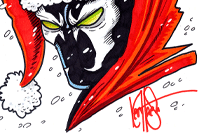JONATHAN HENNESSEY
 SEND THIS TO A FRIEND! SEND THIS TO A FRIEND!
DF Interview: Epochalypse breaks free from between Jonathan Hennessey’s ears By Byron Brewer Epochalypse is a new science fiction comic that turns the usual time travel story inside-out! Herein, we have a mysterious event that makes everyone spontaneously time travel. And no one has any control over where they end up. In fact most people don’t survive the jump! Plus, no one seems to know how to get back home. So we’re left with a world where 600 years of history have collapsed into a single new timeline. Elements from the late 1500s all the way to the 2100s have been smashed together. People, ideas, technologies, languages and cultures that were never meant to co-exist are suddenly — and possibly permanently — side by side. To get more on this high concept comic, Dynamic Forces talked with writer Jonathan Hennessey to see what other shockers were “up there in that space between the ears.” Dynamic Forces: This is some high concept sci-fi, and especially for a writer known primarily for non-fiction works. How long has Epocayalypse been developing in your brain? Jonathan Hennessey: Epochalypse, yes, has had a long gestation period up there in that space between the ears. You can measure the length of time by the revolving carousel of obsolescent computer technology, even. Because I'm almost positive that the earliest written-down synopses, scenes, pitches, and character sketches exist only on 3.5" floppy disks whose data I now have no immediate ability to access. (Isn't that the same state of affairs with NASA's old Viking Lander? That it sent back reels and reels of scientific observations on magnetic tape that no extant machine can transcribe?) The earliest paper trail evidence I can find for Epochalypse — at least that still has a date on it — is 2004. I'll gratefully accept the complement of your calling it "high concept." The bigger question, of course, is whether or not the setting, characters, tone, plot, dialogue, and themes are up to snuff. That we'll have to defer to readers, naturally. But in any event, with this long interval between forming the idea and getting a first 24-page issue out on store shelves, I've been sort of white-knuckling it the entire time. I've been gnashing my teeth over the possibility that some other project, wholly independent of me, would come along with the same basic idea. That happens all the time. And the core concept here — my way of turning the mainstream time travel story inside out — is a lightbulb that could have blinked above the heads of legions of clever writers at any time. Arguably, if the Epochalypse idea were to be exploited once, by somebody else, it would be done. Kaput. No fresh departure with different characters or plot alterations could withstand a play by the dreaded copycat or plagiarist card. (Here's an example of the kind of entertainment industry trade blurb that for years upon hearing would put my limbic system on high alert: "XXXX announced today they are commencing principal photography on sci-fi time-jumping pic Looper. Plot details are being kept under wraps, but the concept is said to be a 'lightning in a bottle' new approach to time travel.") DF: Was there a piece of fiction or fact, of media or writing that inspired this concept? Jonathan Hennessey: Nice — I haven't been asked that before. Well, as a youngster I had a voracious appetite for Japanese anime. But within my current fanboy age bracket, I remember a galling dry spell in which I was left with absolutely no way to watch more. In the Boston media market where I grew up, once upon a time the UFH airwaves had been graced with a really solid number of anime shows, from Speed Racer to Star Battles to Captain XXXXX to Battle of the Planets. Then some high-strung parents' groups went berserk over the content of some these shows: a kinky female mecha whose breasts could shoot like missiles, characters who died and stayed dead, interracial relationships, and occasional glimpses of nudity. The censors were able to get all this stuff pulled from the air. So I was left with lying to my parents about my whereabouts, and taking a long, slow, rickety bus ride from the suburban shopping mall I could reach by bicycle mall to downtown Boston. There I could make my way over to the UMASS-Boston campus and watch the likes of Nausicaa or Vampire Hunter D with a small group of adults called The Boston Japanimation Society. During one of those screenings I first saw the feature Megazone 2-3. That film posited a whole population of civilians who seem to be leading normal, modern, 1980s lives. But the main character eventually learns that they all have been obliviously packed away inside an enormous starship, many centuries after the Earth had been destroyed by a hostile alien race. That blew my mind! And definitely something about the characters believing they exist in one part of history when in actuality they are trapped in an horrific far future stuck with me. And informed Epochalypse, DF: Can you tell us the evolution of Epocayalypse through its various iterations, and what is "Synchroni-City"? Jonathan Hennessey: Synchroni-City was just my initial name for the whole project. Once the idea and a few key characters were in place, it did not change much — but only deepened and began to develop more ambitious and sophisticated themes. One of the benefits to not really getting a "big break" as a younger man was that Epochalyse grew with me as I became older and accrued a wider knowledge of history and human nature. Though few of them are principal characters, the children of Epochalypse are in a very precarious position in their world. These so-called "Slips" are special to me — and to the endgame of the plot of Epochalypse. Now, as a father myself, I have a whole different approach to child characters where in my 20s it would have been easy to be simply sentimental and precious about them, or even acerbically flip. DF: So tell us about the world of Epocayalypse, what has happened and what the characters are moving toward? Jonathan Hennessey: Epochalypse turns the typical time travel adventure inside-out. Usually you have one person or a team of adventurers choosing some destination in time and proceeding there. In Epochalypse, however, some inexplicable event has caused everyone to spontaneously time travel. And no one had any choice about where they would end up. In the standard model, in something like Timecop, you have heroes struggling to protect history from being manipulated to one sinister end or another. But again, in Epochalypse history is already irretrievably shattered beyond recognition. People from as early as the 1590s all the way to the 2100s have been pulled into 1951. The dislocation was so massive and so violent that only a few tens of thousands survived the trip: the gargantuan number of less lucky ones died horrible deaths merging with another person or inanimate object who had been taking up their current space in another time period. (Survivors happened to be in places that withstood the least net physical change or "traffic" over the years: distant wildernesses, old houses with few occupants, rural hamlets, caves. Busy cities, highways, shipping lanes, and air travel routes, on the other hand, all became meat grinders of death). So Epochalypse leaves us with a post-disaster setting where the past, present and future — people, cultures, ideas and technologies that were never meant to exist — are suddenly (and seemingly permanently) side by side. Civilization was brought to its knees. But within a few years, a mysterious group of scientist/administrators calling themselves The Trustees made their presence known. They claimed to be in the initial stages of returning history to normal — to sending people back to their "home times." But there was a problem. Everything and everyone that arrived from the year 1952 or later is reportedly radiating with invisible waves of "timeline turbulence." This energy interferes with The Trustees' experiments. It destabilizes the fragile fabric of local, post-disaster space-time. Things from the past, in contrast, exert a stabilizing force on the survivors' surroundings. So the Trustees constituted an elite police force of characters from 1951 and earlier called Resynchronizers. Resynchronizers had to be smart, self-aware, mentally flexible and physically capable. They were trained to locate people and artifacts from the future, and given a small number of advanced devices to be carefully used in their mission to contain and neutralize all "anachronisms." The Resynchronizers and Trustees are working together to restore history. But, problematically, this is something they can only do by instigating what is effectively a civil war between the future and the past. By the time we open Issue #1, that civil war has been playing out for 14 years. And the past seems to be the victor. DF: Tell us about Johanes, very clearly the hero of this piece. What is his back story and what challenges face him? Jonathan Hennessey: Our hero, Johannes Van der Honing, is a Resynchronizer lieutenant. He has been posted to one of The Trustees' provincial territories, well removed from the private and mysterious compound of the overlords and the bustling civilian boomtown that has sprung up around it. Johannes was an Amsterdam merchant's young son from the 1640s. He had only been in the New World for a few days when he was dislocated. And that was just seconds after a nasty combination of bloodthirtsy French mercenaries and revenge-hungry Indians beset Johannes's family — including the father he absolutely hero-worshipped and who had just moved heaven and earth to win release from a long prison sentence back in Holland. The Van der Honings were victiorisuly embarking on a bold new life. They would have been some of the most important people in the New Netherlands. But it all got ripped away from them in the blink of an eye, due to circumstances that they had no direct involvement in whatsoever. Resynchronizers, for their valiant service to The Trustees, are promised the award of being able to go live in any time period they want. Epochalypse is not so hung up on the question of time travel paradoxes, you see. The only paradoxes that have real implications for the order of the universe would be alterations of events that involve huge amounts of matter and energy. The human-scale events we tend to wring our hands over — what would happen if you killed Hitler, aborted your mother, gave machine guns to Gengis Khan — are in Epochalypse no more than bubbles inside bubbles of the cosmic quantum foam. That's a long way of saying that The Resynchronizers are well aware that they can go home and use their knowledge of the future any way they choose. And Johannes is dead-sighted on the idea of going back to 1645 and preventing the massacre that took his beloved father, mother and sisters from him. In other words, he is a true-blue believer in The Trustees, their mission, and their methods. And although Johannes is far more empathic and gentle than most comic book heroes — he knows every survivor carries the same pain and existential questions he does — he also has a dark, aggressive, impulsive side. This tends to comes out when he sees someone standing between himself and the reunification of his family. And as the story opens, a shadowy figure called The Salesman has been dogging Johannes for months and months. The Salesman brazenly peddles anachronisms door to door. In spite of the harsh laws against anachronisms, nearly all people from the past yearn to possess them. And we're not just talking fun gadgets, but also life-saving medicines and advanced tools that can save years of hard labor. This black market for anachronisms becomes a more and more pressing problem as the lag time between The Trustees' promises and their results gets longer. The Salesman is emblematic of the rumblings that The Trustees don't know what they're doing — and it's time for everyone to stop clinging to the past and move on with their lives. Johannes faces the steep tasks of catching The Salesman, discrediting him to a population that is coming to think of him as a folk hero, and rounding up all the anachronisms he has spread in every direction — almost as if The Salesman's M.O. is to set off a massive time turbulence bomb and blow a hole in the corner of space/time that, for the moment anyway, appears to be stable enough to support human life. DF: I understand Johannes has a rather unique team of cohorts. What can you tell us about them? Jonathan Hennessey: Johannes's partner is Frank, displaced from the early 1930s. Frank, a hearty and manly old school slugger, was a U.S. Marine Corps vet from World War I. We'll soon find out that he was a federal Prohibition Agent in the latter years of his life, which is where he became trained as a law enforcer and took some formative lumps tangling with the mob. A dispositionally silent, intelligent and uber-capable force-to-be-reckoned-with within their unit is Nyakwye. Nyakwye was an escaped slave from 1822 trying to make his way from Virginia to Canada. The Trustees easily have earned Nyakwye's loyalty. For they have effectively ended slavery — and in fact have taken all African-Americans to be social and political equals. Although Nyakwye knows that undoing the time-disaster will restore slavery, he now realizes that the institution was doomed to failure anyway. Meanwhile Nyakwye is, on the sly, recruiting a ring of black spies and informants he also hopes to convince The Trustees should be resettled well after the Civil Rights period. Our hero's boss, a Resynchronizer captain, is from the 1890s, a career law enforcer and politico who clawed his ways to the inner circle of New York State politics. But a big surprise about his identity comes out in Issue #7. And we'll also be getting to know the other Resynchronizers, Paula and Suresh, as well as Ramona, the beautiful object of Johannes's forbidden desire, along the way. DF: And the big-bads? Jonathan Hennessey: I like my villains with three dimensions, and I like them to challenge and chew apart the heroes psychologically and morally. So the bad guys here usually arise out of circumstances or have an agenda that even the good guys might find some logic in and sympathy for. We'll soon see what kind of people The Salesman has been getting into bed with, including someone whom the time dislocation gave a second chance to be a gun-toting, anti-establishment badass. Epochalypse gets to go beyond the good vs. evil oversimplification because the collision of timelines has created so many overlapping and competing ambitions, few of them objectively evil in their own context. To me — and hopefully to comics fans out there — that will be even more exciting than another dustup with zombies or alien robots or supervillains. DF: Why is Shane Davis the right artist for this book? Jonathan Hennessey: What can you say about Shane? The man could teach a master class in how to lay out an action sequence. But he can also stun you with his command of the microelements that make up an intimate, revealing human expression. This is just the thing for any story that aspires to combine compelling battle scenes and sweeping vistas with heartfelt, provocative, human-scale drama. Shane has a clear, unmuddied style that remains fluid without ever seeming staid and overproduced. This was a shot in the arm for Epochalypse because of how crucially the series needed its wide array of historical people, places and things to both gel together on the one hand, and stand distinctly apart on the others. Epochalypse is all about these kinds of contrasts. After getting the book off to a strong start, he is off to other things, and I'll always be grateful for his expertise (and Legendary Comics' putting us together) and looking forward to what he tackles next. Dynamic Forces would like to thank Jonathan Hennessey for taking time out of his busy schedule to answer our questions! Epochalypse #2 will be in stores today, December 24th!
NEW! 1. 09/23/2025 - FRANK BARBIERE2. 09/16/2025 - RODNEY BARNES 3. 09/10/2025 - ZACK KAPLAN 4. 08/26/2025 - JOE PRUETT 5. 08/20/2025 - CHRISTIAN WARD Show All |







